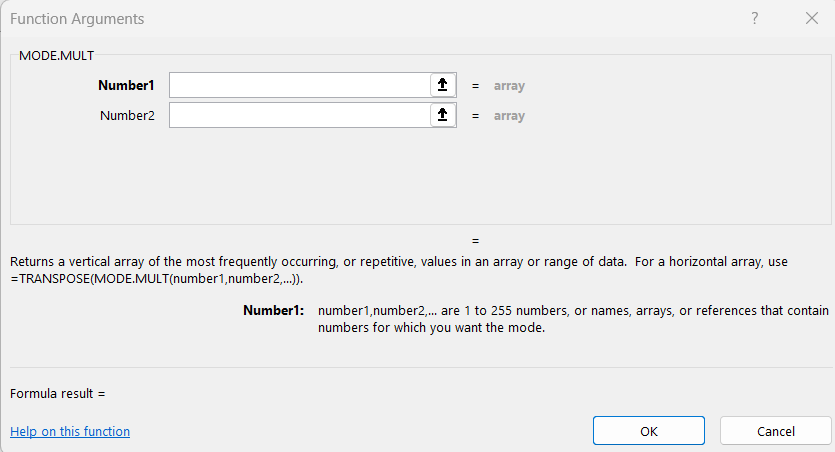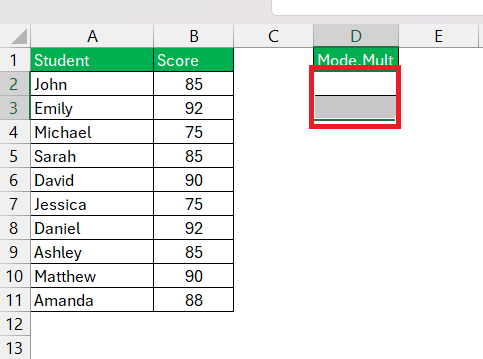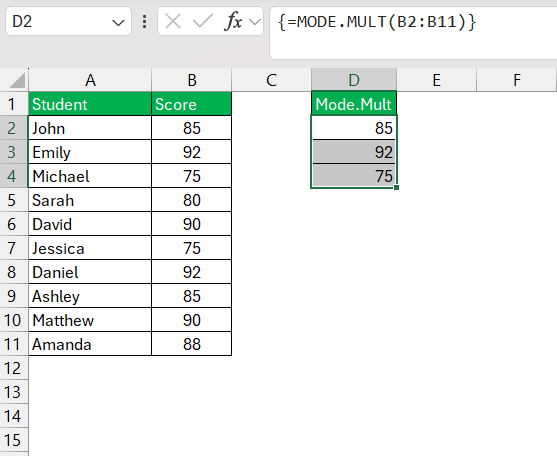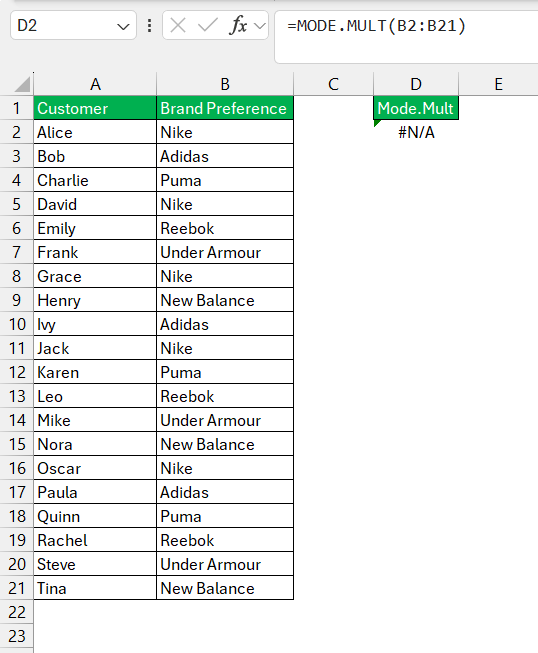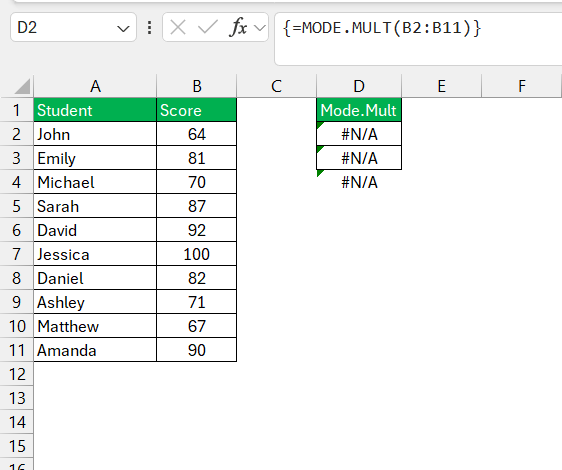The MODE.MULT function in Excel is a powerful tool for statistical analysis, allowing you to find the most frequently occurring values in a dataset. Unlike its predecessor, MODE.SNGL, which only returns a single mode, MODE.MULT can identify multiple modes, making it ideal for datasets with more than one repeating value. This article will guide you through the usage, syntax, and practical applications of MODE.MULT, helping you leverage this function to enhance your data analysis capabilities.
Key Takeaways:
- Versatile Mode Identification: MODE.MULT can identify multiple modes in a dataset, unlike MODE.SNGL, which only finds a single mode.
- Flexible Syntax: The function accepts multiple number arguments or ranges, making it adaptable to complex datasets.
- Array Formula Requirement: For versions prior to Excel 365, enter MODE.MULT as an array formula by pressing Ctrl+Shift+Enter to see all modes.
- Real-World Applications: Use MODE.MULT for analyzing customer preferences, healthcare data, sales figures, and quality control metrics to identify common values.
- Common Pitfalls: Ensure you’re working with numerical data, provide enough output cells, and remember that MODE.MULT returns #N/A if there are no duplicates in the dataset.
Introduction to Excel’s MODE Functions
Understanding MODE.MULT and Its Versatility
Excel’s MODE.MULT function is a hidden gem for analyzing statistical data. This useful formula doesn’t just stop at finding the most common single value in my data; it goes further. If my dataset contains multiple values competing for the top spot, MODE.MULT lists them all, giving me a comprehensive view of the modes present.
Its versatility is a standout feature, accommodating more complexity in datasets, whether I’m dealing with customer surveys, sales figures, or any other scenario where multimodal patterns emerge.
The Evolution of Excel Statistical Functions
Excel’s journey in the realm of statistical functions has been extensive, constantly evolving to meet the growing demands of data analysis. From the early days of basic functions like SUM and AVERAGE, Excel has expanded to include a suite of sophisticated tools. Among these, statistical functions have seen significant advances, evolving from simple computations to complex data interpretation capabilities.
The introduction of MODE.MULT, in particular, signifies a shift towards accommodating datasets that challenge the simplicity of single-value analysis. Over the years, these enhancements have transformed Excel from just a spreadsheet tool into a powerful ally in statistical data processing and decision-making.
Demystifying MODE.MULT for Excel Users
Basics of the MODE.MULT Function
Getting to grips with the MODE.MULT function is all about understanding its foundations. At its core, MODE.MULT is designed to pinpoint the most frequently occurring numbers, or modes, within your data set. Imagine you’re sorting through a list of customer order quantities and want to stock your inventory accordingly. MODE.MULT will return every number that pops up most frequently, not just the single most common figure.
The syntax for the formula is straightforward:
Where ‘number1’ is the first number argument, and ‘number2’ to ‘number_n’ are additional numbers or ranges you’re examining. Notice how flexible it is – MODE.MULT doesn’t stop at a single range but accepts multiple arguments, making your data analysis all the more robust.
When and Why to Use MODE.MULT in Excel
When delving into datasets with possible multiple modes, MODE.MULT proves to be your go-to Excel function. Let’s paint a picture of when it becomes invaluable: Imagine you’re an educator sifting through a pile of test scores to identify the most common results. MODE.MULT will list all the highest frequency scores, allowing you to address any trends in the classroom swiftly.
Why choose MODE.MULT? Because sometimes, the full story isn’t told by just one number. Real-world data can get messy, showing multiple values taking the lead in frequency. MODE.MULT empowers you to unveil these patterns, informing better decisions whether you’re managing stock levels, streamlining operational processes, or seeking insights in customer behavior patterns. It essentially enhances the reliability of your statistical analysis by acknowledging the complexity of real-world data.
Step-by-Step Guide to Using MODE.MULT
Entering MODE.MULT Formulas with Ease
When you’re ready to dive into the MODE.MULT function, entering it as an array formula allows Excel to showcase its full potential. Here’s how to do it with ease:
STEP 1: Suppose you have a column of numbers in B2:B11 and want to identify all the modes.
STEP 2: Highlight the range where you want to display the modes, say cells D2:D4.
STEP 3: Then type in =MODE.MULT(B2:B11) in the formula bar— but here’s the key: hold off on hitting ENTER just yet. Instead, press Ctrl + Shift + Enter together. Excel adds curly braces around your formula, showing it’s an array formula: {=MODE.MULT(B2:B11)}.
Now, D2, D3, and D4 are like a small team working together, each displaying a mode.
To tweak or remove this multi-cell array formula, remember to select the entire range, D2:D4 in this case, before making any changes. With practice, entering MODE.MULT array formulas become second nature, unlocking new possibilities in data analysis with just a few keystrokes.
Real-World Examples to Practice MODE.MULT
Putting MODE.MULT to work in real-world scenarios is the best way to understand its value. Consider a market research situation where you have collected data on customer preference for several product features. Using MODE.MULT on the dataset reveals which features pop up most frequently as customer favorites.
Another example could be in healthcare data analysis. Let’s say you’re looking at the number of steps walked by patients in a recovery program. By applying MODE.MULT to the step count data, you can identify the common daily step counts, effectively pinpointing the activity levels that patients are achieving most frequently.
In finance, MODE.MULT can be used to identify the most common sales figures across different regions. This could help in understanding regional preferences and inform targeted marketing campaigns.
Lastly, in quality control within manufacturing, MODE.MULT could help pinpoint the most commonly reported defects or failure rates, ensuring that quality assurance processes are directed effectively.
Tips and Tricks for MODE.MULT Mastery
Avoiding Common Pitfalls with MODE.MULT
To master MODE.MULT and avoid common pitfalls keep these tips in mind: First, remember that MODE.MULT is meant for numerical data – feeding it text or non-numeric values can lead to errors.
Second, be aware of its array nature. If you’re using a version prior to Excel 365, you must enter it as an array formula, this means pressing Ctrl+Shift+Enter, not just Enter.
Another common mistake is not providing enough cells for the function’s output. If MODE.MULT identifies more modes than the range you’ve selected, it won’t show the full results. So, when in doubt, select a few extra cells.
Also, remember that MODE.MULT returns #N/A if there are no duplicate numbers in your data – it’s a sign that there isn’t a mode, not necessarily that something went wrong.
Finally, when sorting your data, ensure you’ve got a backup. Modifying or sorting the dataset after you’ve applied MODE.MULT could shift results and cause confusion.
By sidestepping these pitfalls, you’ll make the most out of MODE.MULT and keep your data analysis smooth and error-free.
FAQ: Getting More from Your MODE.MULT Experience
How to use mode mult formula in Excel?
To use MODE.MULT in Excel, select a range where you want to display multiple modes. Enter =MODE.MULT(range) as an array formula by pressing Ctrl+Shift+Enter, which will reveal all frequent numbers in your selected dataset.
What is the primary function of MODE.MULT in Excel?
The primary function of MODE.MULT in Excel is to return a vertical array of the most frequently occurring numbers, or statistical modes, in a given dataset, highlighting all the numbers that share the highest frequency.
What is the difference between mode mult and mode single in Excel?
MODE.SNGL returns the single most frequent value in a dataset, while MODE.MULT identifies all values with the highest frequency, outputting a vertical array of multiple modes, if applicable.
Can MODE.MULT be used with array functions, and how?
Yes, MODE.MULT can be used with array functions. In Excel 365 and later, it’s native as an array formula, but in earlier versions, combine it with CTRL+SHIFT+ENTER to output multiple modes across an array. Use with functions like TRANSPOSE to flip the array orientation.
Are there any alternatives to MODE.MULT in statistical analysis?
Yes, alternatives to MODE.MULT include using frequency distribution tables, pivot tables for mode analysis, or statistical software like R and Python for more complex multimodal distributions.
John Michaloudis is a former accountant and finance analyst at General Electric, a Microsoft MVP since 2020, an Amazon #1 bestselling author of 4 Microsoft Excel books and teacher of Microsoft Excel & Office over at his flagship MyExcelOnline Academy Online Course.

